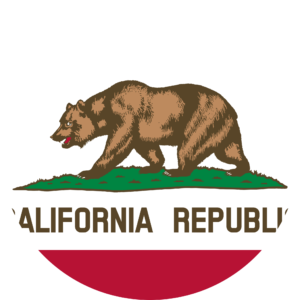California sales tax guide

In need of personal consultation?
Register for a consultation with Edgaras. It is completely FREE and you will get many questions answered!
Book a Free consultationWelcome to 1stopVAT’s guide on sales tax for California. By reading the information below, you will learn what is the sales tax rate in California, how you can get California sales tax (CA) permit, and how to submit returns for California sales tax online.
California state sales tax in a nutshell
A sales tax (in some countries outside the US called the VAT) is a tax that is paid on the sale of goods or services and falls on the end-consumer. Once a business establishes a nexus in California, it is held responsible for collecting the right amount of sales tax and submitting it to the state of California. The total sales tax rates California based businesses have to charge vary based on the district of origin and the district where the customers are based. In addition to the sales tax, California has also established transaction taxes called the sellers and consumer use tax, respectively. The seller use tax has to be collected by the sales tax in California (CA) exempt businesses, whenever no sales tax was collected on sale that qualifies for the tax and a business in California stores or uses taxable items that were bought tax-free. Consumer use tax comes in place whenever the seller fails to collect the sales tax. In such a scenario, the consumer can report, file, and remit the use tax on the annual tax return.
Do you need to collect California sales tax?
Businesses must collect the correct California sales tax percentage if they meet three criteria:
- A business has a nexus in California;
- A business is selling taxable services or goods to Californians;
- Buyers of the goods or services are required to pay sales tax.
If you meet all of them, it means that you have a strong tie with the state, in the tax vocabulary called a nexus, which implies that you should collect, file, and remit taxes in the sales tax California.
Do you have a nexus in California?
Since 2018, states can tax businesses that have a virtual or economic nexus in addition to the physical nexus that used to be the only criteria to becoming a sales tax collector before. While physical nexus is a simple concept, signifying that whenever a business has an office, warehouse, store, or other physical location in the state of California, it has to become a sales tax collector, other types of nexuses require a more extensive explanation. Here are the types of nexus that establish a virtual or economic connection with the state of
| ▶ A representative in California. If you have a person who serves as a contractor, representative, agent, salesperson, or another similar role who takes orders and executes them in California, you are eligible for paying the sales tax in the state. | ▶ An affiliate or ‘click-through’ nexus. When sales from affiliates, who directly or indirectly refer you to the buyers, exceed $10,000 in the last 12 months and your total sales in California exceed $1 million in the same period, you become a sales tax collector. | |
| ▶ Inventory in the state nexus. This nexus becomes active when you store inventory for sale in California, including in a warehouse that belongs to Amazon. | ▶ Marketplace sales nexus. If you run a marketplace in the state of California that surpasses the economic nexus threshold, you are obliged to collect the sales tax on behalf of the sellers using your platform. |
- Marketplace sales nexus.
If you run a marketplace in the state of California that surpasses the economic nexus threshold, you are obliged to collect the sales tax on behalf of the sellers using your platform.
- Economic nexus.
Retailers that have exceeded $500,000 in annual taxable sales are considered to have an economic nexus. These retailers become obliged to collect the use and district taxes. For out-of-state retailers, the requirement to collect sales tax comes in place when the volume of sales for delivery into California exceeds $100,000, or the retailer makes sales for delivery into California in at least 200 separate transactions.
Taxable goods and services in California
If you have a sales nexus in California, it does not necessarily mean that you have to collect tax for all goods and services that you sell. Typically, sales services in California are not taxable. For taxation of goods, it is best to refer to the Business Taxes Law Guide of California as it includes a list of tax-exempt goods. The goods you do not need to tax range from some food items to camp vehicles purchased from an out-of-state dealer.
Registering for a sales tax permit in California
The institution responsible for issuing permits for sales and use tax California is called the CDTFA or California Department of Tax and Fee Administration. Using the CDTFA’s website, you can find up-to-date information on what is the current sales tax in California and other questions. To register for a permit, you should either proceed with an online registration process on their website or visit one of CDTFA’s field offices. Register for becoming a sales or use tax collector is free of charge. To complete the registration, you will be asked to fill in all your business identification details and pay a security deposit in case your business has unpaid taxes.
How much is the sales tax in California?
The statewide California sales tax rate is 7.25 %. However, you should not calculate California sales and use tax by considering this number only. To determine what’s the sales tax in California that should be applied to you, you should look at the district where your customers are located and also the district of your business. This model is called a hybrid-origin collection. If you are located outside of California, you should add only the district California tax sales of your buyer. Local jurisdictions in California usually have district taxes that range from 0.1% to 3.25% and need to be added to the sales tax. To identify the sales tax rate California districts have, you can either consult with 1stopVAT’s team or use our Sales Tax Calculator. Keep in mind that some areas can have more than one district rate added to the California state sales tax rate.
Collecting and filing the sales tax
- Once you have found out the applicable California sales tax rates, you might want to learn the right way of collecting and filing these taxes.
- Upon the sales tax permit registration, you will be assigned a frequency of returning the sales tax. It can be monthly (unusual), quarterly, twice a year, or annually. Sales tax reports are due on the last day of the month that follows the end of the period.
- To file the sales tax, you will have to calculate how much sales tax you owe, file the sales tax return and pay the CDTFA. You can calculate how much sales tax you owe by multiplying the cost of the items sold by the sales tax rate in California.
Need assistance with California sales tax?
We can help!
Dedicated account manager
As our client, you will be assigned to a multilingual account manager who can address all your tax-related inquiries and resolve any issues you may have at any time.
Single point of contact
We serve as single point of contact, simplifying the process and ensuring that your VAT compliance is handled efficiently and effectively within single stop.
Exclusive customer service
We support our clients, ensure fast response time and always go beyond by offering tailored assistance and individual attention.
Certified experts
Our team is combined of more than 30 experts, who can provide wide range of services and are certified members of IVA, AITC and VAT Forum. Currently we have more than 500 clients and knowledge how VAT works in 100 locations.



